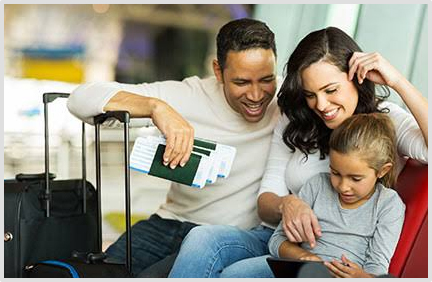from ACCEL, Arizona Centers for Comprehensive Education and Life Skills
 As a parent, you may experience a lot of anxiety in knowing you will soon have to travel with your child with autism—especially when traveling long distances.
As a parent, you may experience a lot of anxiety in knowing you will soon have to travel with your child with autism—especially when traveling long distances.
However, there are proven methods to help make your travel as easy and painless as possible.
Routine, Routine, Routine
Parents and caregivers of children with autism know that adhering to a routine is important in their child’s daily life, and travel days should be no different. Too much deviation from routine, even on the smallest details, can lead to tremendous anxiety and tantrums that may only get worse for the duration of travel.
The night before you leave and the morning of, do everything you would normally do on a typical day. This would be everything from laying out clothes, to bedtime reading, to bath routines, to the placement of toys or electronic devices, to having breakfast.
Just as important, do your best to follow your at-home routines even when you are away. This predictability reduces stress and anxiety, helps the child feel more in control, and makes the trip less stressful.
Some experts recommend turning the travel date into an event marked on the calendar, something to look forward to. Make travel something exciting and new, not something to dread, or be afraid of.
Prepare for Anything
Here are some tips to help you prepare for your trip:
- Have documentation of your child’s diagnosis ready, in case airline or hotel staff request it.
- Make sure you have any stuffed animal, toy, book or electronic device that might be soothing to your child should something unexpected occur.
- If your child is sensitive to loud sounds, bring noise-canceling headphones.
- Bring a change of clothes in case of spills.
- Try to bring something reminds them of the comfort of home, whatever that may be.
- Don’t forget snacks or meals, especially if it will be a long trip.
- Above all, go over everything you’ve packed in detail and make sure you have everything you may need. It is always better to pack too much than pack too little.
The single most important factor in traveling with a child with autism is to avoid surprises.
That is why you should begin to prepare your child weeks in advance of the travel date, going over every detail of the trip, no matter how small, and every possible scenario.
Safety Above All
As parents of children with autism are well aware, wandering off is a problem for almost half of all children diagnosed with autism. In these situations, children attempt to wander or run from a safe, supervised area and find themselves in a strange, dangerous place, or go missing altogether.
This can happen when the child is no longer familiar with the surroundings. So when you travel, it is imperative that you not only keep an extra close eye on your child at all times but also have the child wear a medic alert bracelet with his or her name and contact information.
If you do not have a medic alert bracelet, consider using a GPS tracker. This can give you the peace of mind of knowing where your child is at all times, even if they wander off.
Even if they have a GPS device, make sure they also have some form of identification on them at all times, along with medical information, so emergency professionals can provide the right help immediately if a problem arises.
The National Child Identification Program offers kits you can use to easily create an ID packet for your child, including a fingerprint and DNA sample, along with standard information like height and weight.
This is a very helpful resource for law enforcement or emergency responders who may find your child after you get separated.
One last piece of advice: Try to have fun. After all, as frustrating as air travel may be, it is still time you get to spend with your loved one.











